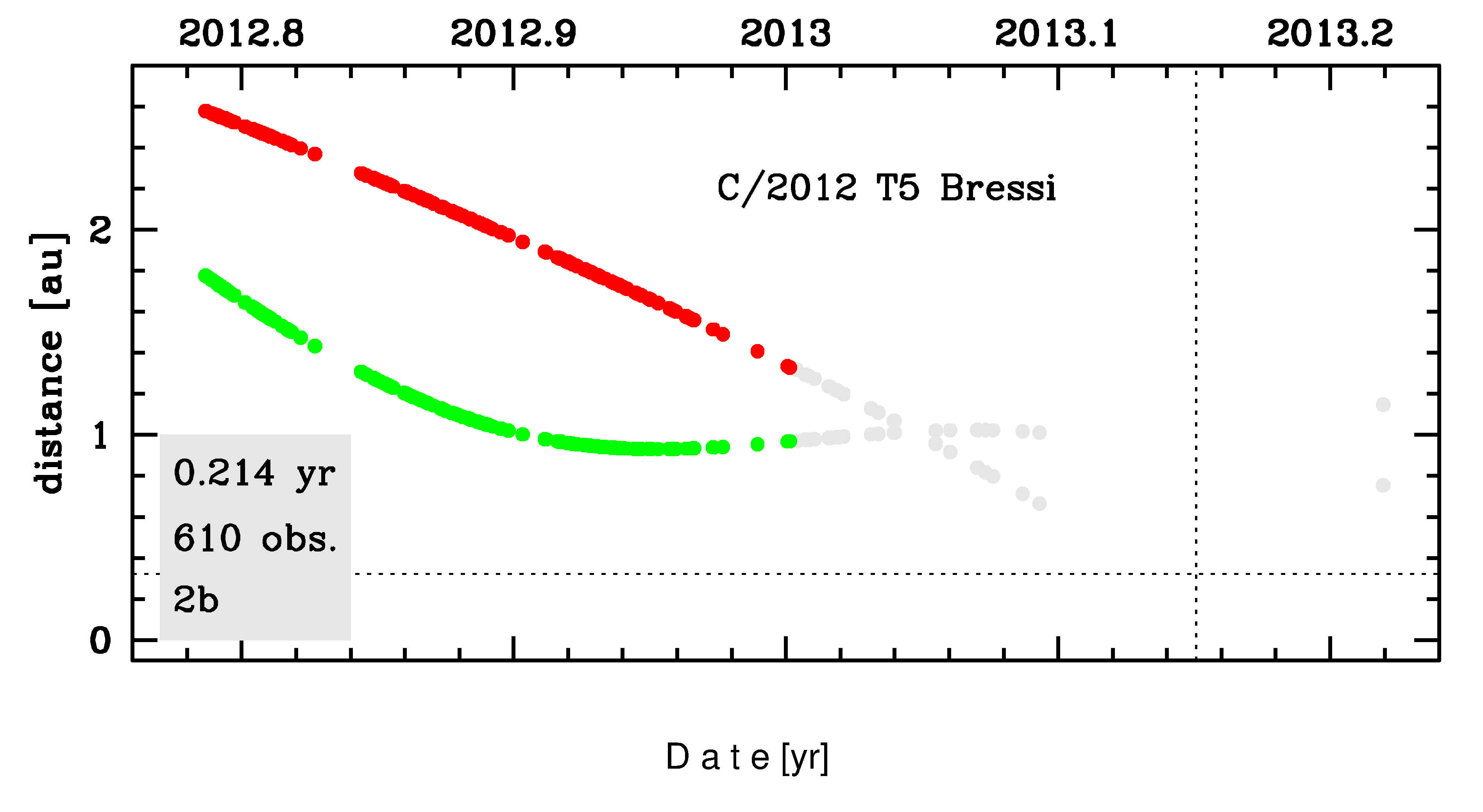C/2012 T5 Bressi
more info
Comet C/2012 T5 was discovered on 14 October 2012 by Terry H. Bressi (Spacewatch), that is more than 4 months before its perihelion passage. It was observed until 21 March 2013 (see picture).
C/2012 T5 had its closest approach to the Earth on 25 February 2013 (0.913 au), a day after its perihelion passage.
Comet was lost a month after perihelion passage and Sekanina (2019) concluded that this Oort Cloud comet did not survive the observed perihelion passage.
Original value of 1/a is significantly negative for solutions based on entire data set. The preferred solution (based on pre-perihelion data taken at larger heliocentric distances than 1.33au) gives also negative value of original 1/a; however, within its uncertainty of about 1.5 sigma this comet can came from the Oort Cloud.
See also Królikowska 2020.
C/2012 T5 had its closest approach to the Earth on 25 February 2013 (0.913 au), a day after its perihelion passage.
Comet was lost a month after perihelion passage and Sekanina (2019) concluded that this Oort Cloud comet did not survive the observed perihelion passage.
Original value of 1/a is significantly negative for solutions based on entire data set. The preferred solution (based on pre-perihelion data taken at larger heliocentric distances than 1.33au) gives also negative value of original 1/a; however, within its uncertainty of about 1.5 sigma this comet can came from the Oort Cloud.
See also Królikowska 2020.
| solution description | ||
|---|---|---|
| number of observations | 610 | |
| data interval | 2012 10 14 – 2012 12 31 | |
| data arc selection | data generally limited to pre-perihelion (PRE) | |
| range of heliocentric distances | 9.39 au – 1.33au | |
| detectability of NG effects in the comet's motion | comet lost close to perihelion or split comet | |
| type of model of motion | GR - gravitational orbit | |
| data weighting | YES | |
| number of residuals | 1208 | |
| RMS [arcseconds] | 0.75 | |
| orbit quality class | 2b | |
| previous orbit statistics, both Galactic and stellar perturbations were taken into account | ||
|---|---|---|
| no. of returning VCs in the swarm | 136 | |
| no. of escaping VCs in the swarm | 4865 | |
| no. of hyperbolas among escaping VCs in the swarm | 4483 | * |
| previous reciprocal semi-major axis [10-6 au-1] | -60.62 – -30.51 – 0.38 | |
| previous perihelion distance [au] | 0.98 – 1.5 – 2.1 | |
| previous aphelion distance [103 au] | 80 – 230 – 1600 | |
| time interval to previous perihelion [Myr] | 1.42 ± 0.0012 | |
| percentage of VCs with qprev < 10 | 100 | |
| previous_g orbit statistics, here only the Galactic tide has been included | ||
|---|---|---|
| no. of returning VCs in the swarm | 129 | |
| no. of escaping VCs in the swarm | 4872 | |
| no. of hyperbolas among escaping VCs in the swarm | 4480 | * |
| previous reciprocal semi-major axis [10-6 au-1] | -60.52 – -30.44 – 0.43 | |
| previous perihelion distance [au] | 0.65 – 0.91 – 1.2 | |
| previous aphelion distance [103 au] | 81 – 230 – 1500 | |
| time interval to previous perihelion [Myr] | 1.45 ± 0.0012 | |
| percentage of VCs with qprev < 10 | 100 | |
